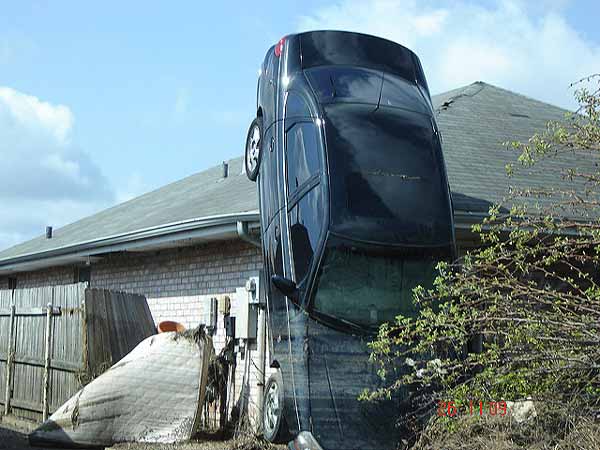EVENT - First Day of Thoth
 Today is August 29. It is the Egyptian New Year - the first day of
Thoth. Thoth is the Ibis-headed god of knowledge. In deference
to Thoth, on this date in history:
Today is August 29. It is the Egyptian New Year - the first day of
Thoth. Thoth is the Ibis-headed god of knowledge. In deference
to Thoth, on this date in history:
1350 - King Edward III laid major pwnership on the Castilian fleet in the
battle of Winchelsea.
1521 - The Ottoman Turks sacked Nándorfehérvár (Belgrade).
1526 - The Turks lay the whack on the last Jagiellonian king of Hungary and
Bohemia.
1533 - The Spanish garrote the Inca emperor Atahualpa.
1655 - Warsaw falls without resistance to - of all people - Charles X Gustav
of Sweden during The Deluge.
1756 - Frederick the Great attacks Saxony, starting the Seven Years' War.
1786 - A group of armed, ticked-off Massachusetts farmers (who were tired of
high debt and tax burdens) begin Shay's Rebellion. (My, but how times
have changed in Massachusetts...![]() ...)
...)
1861 - Evil Federalists capture the Freedom-loving Confederate fort at
Hatteras Inlet in NC.
1862 - Second Battle of Bull Run - in which the heroic Generals Lee,
Jackson, and Longstreet delivered a glorious butt-whuppin' to the Federalist
terrorist general John Pope in the largest simultaneous mass assault of the War of
Northern Aggression.
1995 - NATO launches Operation Deliberate Force against Bosnian Serb forces.
1997 - The GIA throws a little massacre, known as the Rais massacre, in
Algeria.
2005 - The forces of air, fire, and water joined to form the Army of Katrina which marched unopposed through Louisiana, Mississippi, and Alabama in the opposite direction as Sherman's 'march to the sea' but with rather similar results.
In further deference to the Egyptian god of Knowledge, we should understand the setting for our unfolding drama. Katrina created a disaster that is so wide-spread that getting any kind of a snapshot is all but impossible. How is it to be done? State by state? County by county? Parish by parish? Rather than try to get too involved in it, I am going to ignore most of Alabama and Mississippi and focus most on things that occurred in my direct experience to people and places that I know. That means that I am going to focus on the parishes (counties) most affected in Louisiana. I am also going to focus on the Mississippi coastal area, although there isn't much to say about that except that it was completely erased in many places.
In order to understand what happened in New Orleans and the surrounding area, it is necessary to understand the history and topography of the region. I have always found it amusing that Bienville founded New Orleans as the capital of Louisiana because he said it was 'hurricane proof'. At the time, there was a three foot levee at the river. HA!
I often hear people say, "Why would you live below sea level anyway? That's just crazy!", and other things in that way that are much less politically correct. People who ask those questions do not have any great understanding of history, because if they did they wouldn't ask dumb questions. It isn't as though we all were on a bus coming down from Canada and suddenly said, "Hey! Look at all this sunken swamp land! Let's build us a city right here!"
So, let us open our minds in respect to Thoth and educate ourselves, shall we? How does a city like New Orleans come into existence?
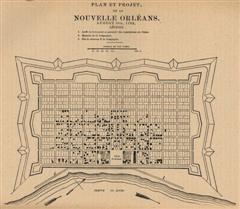 While
many major US cities were still wilderness or small outposts in the middle
of nowhere, New Orleans was awash in hookers and booze. It was the
place to be. It was, is, and always will be a party town. New Orleans is one of the oldest cities on the continent.
It has been shaped over time by its particularly unique geographical,
geological, political, social, economic, and religious conditions. The
French referred to New Orleans as the "Isle d'Orleans." because -
physically and culturally - it is. Decreed a city at its founding by
Bienville in 1718, New Orleans was laid out by the French engineer Adrien de Pauger, in a classic eighteenth-century symmetrical
gridiron pattern. Bienville only managed to build a few huts, a wooden
house for himself, and a makeshift storehouse. No brick building was
built until almost 1730. The 'Cathedral' was just a simple wooden
church. What is now Jackson Square was a muddy area overgrown with
weeds. There was a wooden palisade on the east, north, and west sides,
and a three foot levee held back the river. Even so, the French
needed New Orleans because Baton Rouge - the first actual 'dry land'
upriver - was too far upstream to be strategically and economically viable.
While
many major US cities were still wilderness or small outposts in the middle
of nowhere, New Orleans was awash in hookers and booze. It was the
place to be. It was, is, and always will be a party town. New Orleans is one of the oldest cities on the continent.
It has been shaped over time by its particularly unique geographical,
geological, political, social, economic, and religious conditions. The
French referred to New Orleans as the "Isle d'Orleans." because -
physically and culturally - it is. Decreed a city at its founding by
Bienville in 1718, New Orleans was laid out by the French engineer Adrien de Pauger, in a classic eighteenth-century symmetrical
gridiron pattern. Bienville only managed to build a few huts, a wooden
house for himself, and a makeshift storehouse. No brick building was
built until almost 1730. The 'Cathedral' was just a simple wooden
church. What is now Jackson Square was a muddy area overgrown with
weeds. There was a wooden palisade on the east, north, and west sides,
and a three foot levee held back the river. Even so, the French
needed New Orleans because Baton Rouge - the first actual 'dry land'
upriver - was too far upstream to be strategically and economically viable.
If we hit the fast-forward button, we can watch as hurricanes, floods, and fires erase these structures over and over again. The fire of 1788, for instance, destroyed most of the 'city'. The Spanish had hardly rebuilt it when three hurricanes and another fire - all in 1794 - destroyed all of the reconstruction and the few buildings that hadn't burned in 1788. The existing structures in New Orleans all date from 1795 or later.
There was no drainage, and the miniature levees around houses, streets, and sidewalks kept sewerage and garbage trapped inside them. Labor shortages, high infant (and adult!) mortality rates, disease, mosquitoes, bad sanitation, close living quarters, dampness, heat, hurricanes, fires, and various other plagues kept New Orleans from truly thriving until the 1800's. If you watch too many movies, then you can add vampires and voodoo to the mix. The Spanish slowly improved drainage and built better levees - but without pumps, these were a liability as much as a benefit. There were also innovations in politics. The Spanish governor appointed a City Council, which established a small police force and installed street lights. Night life in New Orleans was born.
New Orleans continued to be an important sea port, but because of that advantage also began to thrive in the hotel, restaurant, and tourism 'industries'. In other words, booze, hookers, and gambling. Still using that fast-forward button, we can observe that a colorful parade of pirates, boatmen, soldiers, an ethnically and culturally diverse citizenry, tourists, and religious figures passes through New Orleans on a regular basis.
Both Spain and France proved unable to hold New Orleans as part of an empire against the Americans flooding into the Mississippi Valley after 1800. Napoleon tried to reestablish the French Empire in Louisiana, taking control of New Orleans back from Spain in 1802; but financial troubles and the difficulty of holding French conquests in Europe and the Caribbean would force him to consider his options.
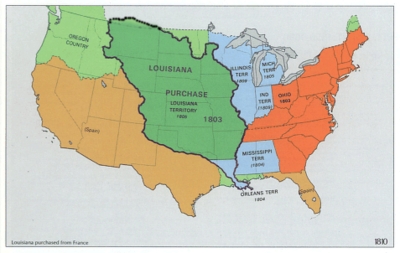 America
was up and coming. The European hold on New Orleans was fading.
New Orleans was not just a wealth of culture and a den of thieves, it was
also the key to strategic control of a large portion of the continent.
It was the key not just to North America, but to other parts of the world as
well. It was a city placed in such a way that its control could
determine the political future of North America. These facts were obvious
not just to early French explorers, but also to Thomas Jefferson, who said,
"There is one spot on the globe, the possessor of which is our natural and
habitual enemy. It is New Orleans." Without any shots being fired,
European rule ended in 1803 with the Louisiana Purchase.
America
was up and coming. The European hold on New Orleans was fading.
New Orleans was not just a wealth of culture and a den of thieves, it was
also the key to strategic control of a large portion of the continent.
It was the key not just to North America, but to other parts of the world as
well. It was a city placed in such a way that its control could
determine the political future of North America. These facts were obvious
not just to early French explorers, but also to Thomas Jefferson, who said,
"There is one spot on the globe, the possessor of which is our natural and
habitual enemy. It is New Orleans." Without any shots being fired,
European rule ended in 1803 with the Louisiana Purchase.
Napoleon got something out of the deal besides money. Upon completion of the agreement he said, "This accession of territory affirms forever the power of the United States, and I have given England a maritime rival who sooner or later will humble her pride."
|
From 1803 until 1861, New Orleans' population
increased from 8,000 to nearly 170,000. In 1810, New Orleans
was the United States' fifth largest city, after New York,
Philadelphia, Boston, and Baltimore. From 1810 until 1840, New
Orleans grew faster than any other American city and by 1830 New
Orleans was America's third largest city, behind New York and
Baltimore. In 1860 it was still the nation's fifth largest
city. New Orleans would remain among the twelve largest U.S. cities
until 1910. Experiments in government created political nightmares for the city, but the primary concern was the constant fight against water - seeping from below, falling from the sky, and flooding in from the river and the lake. As time went on, more and more money was spent on this problem. The merchant class, which controlled City Hall, considered maintenance of the levee system and dock facilities to be the highest priorities. In 1869 the Board of Engineers for New Orleans hired Simmons & Company to evaluate the drainage in the city. That report concluded, "It would be difficult to find a location where the natural drainage is worse than that of New Orleans, owing to a want of declivity in the land, and the tenacious nature of the soil; yet, the problem is easy of solution and presents few difficulties, when we come to apply artificial means, aided by the science and practical knowledge of modern times." No good solution would be implemented, however, for another 44 years. |
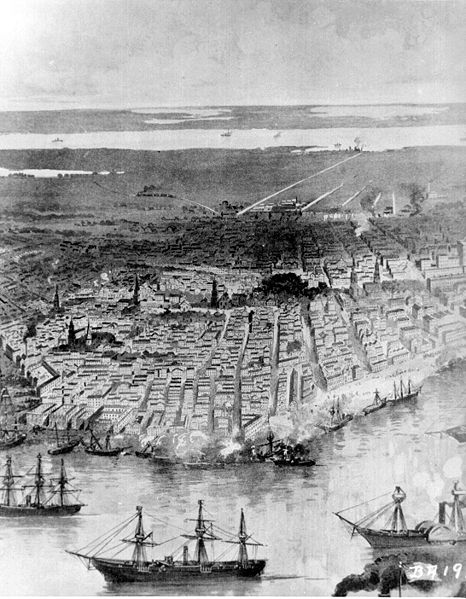
As you can see in this image from 1862, the city is still centered on the river. The area between the river and the lake is occupied by the city itself, some marsh land cut by various canals, some more marsh, and then Lake Pontchartrain.
An 1888 map tells the same story:

The city is spreading out along the river, but the swamp remains a no-man's-land of muck.
New Orleans continued to grow rapidly, and just 30 years later was one of the most modern cities on the continent - but it still suffered from problems of drainage and sanitation.
The man who would finally solve these problems was a man that few people - even locally - have ever heard of. His name was Albert Baldwin Wood (December 1, 1879 - May 10, 1956). Al was an inventor and engineer born and raised here. He graduated from Tulane University with a Bachelor of Science in Mechanical Engineering in 1899 and at the young age of 19 was hired by the Sewerage & Water Board.
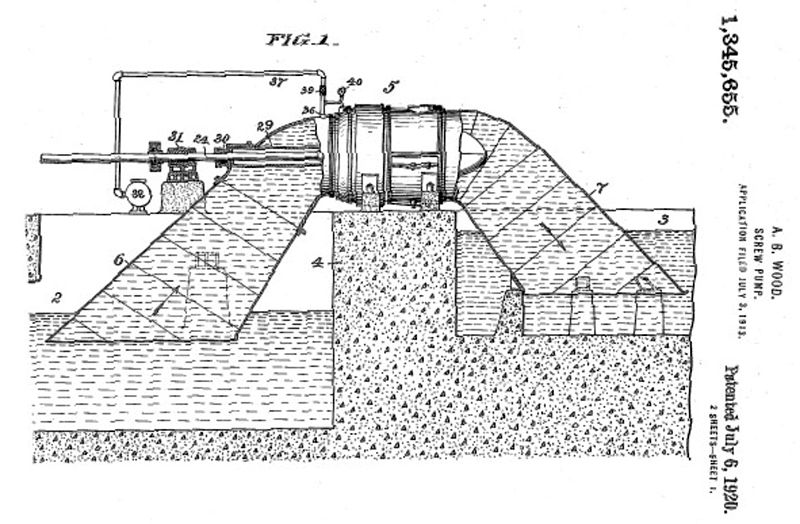 The
man was a mad genius. He proceeded to invent 'flapgates' and various
hydraulic devices. He also oversaw installation of centrifugal pumps
to pump water from the city. By the end of 1913, seventeen large
Pumps, generated by eight pumping stations, managed 4,140 cubic feet of
water per second. The following year the pumps exhibited the continual
improvements with an increased combined capacity of 4,600 cubic feet of
water per second. Total capacity was 2,500,000,000 gallons of water every
twenty-four hours.
The
man was a mad genius. He proceeded to invent 'flapgates' and various
hydraulic devices. He also oversaw installation of centrifugal pumps
to pump water from the city. By the end of 1913, seventeen large
Pumps, generated by eight pumping stations, managed 4,140 cubic feet of
water per second. The following year the pumps exhibited the continual
improvements with an increased combined capacity of 4,600 cubic feet of
water per second. Total capacity was 2,500,000,000 gallons of water every
twenty-four hours.
Al wasn't satisfied with these pumps, however, and his major breakthrough came in 1913 with his patent of the Wood Screw Pump. In 1915, he improved the design and patented the Wood Trash Pump. Through tests, it was proven that just one of Al's pumps would have a total capacity of 5,112,000,000 gallons every 24 hours - more than double the entire capacity of all the pumps in the city.
Al was in high demand, and over time designed and developed drainage, pumping, and sewerage systems for Chicago, Milwaukee, Baltimore, and San Francisco as well as for cities in Canada, Egypt, China, and India. He was one of the men primarily responsible for the Zuiderzee Works, which protected large areas of land from the Zuider Zee in the Netherlands.
In 1914, before the Convention of League of American Municipalities, New
Orleans Mayor Martin Behrman presented a paper in which he said, "These
great public utilities stand as enduring monuments to the courage,
determination and infinite resourcefulness of a people who cheerfully and
with much self-denial made them possible of accomplishment, and no less are
they tributes to the ability, zeal and splendid engineering skill of those
who devised and brought them to a successful consummation, in spite of most
disheartening conditions.
Supplementary to these we have many other improvements of the first
importance, representing a most gratifying development in many directions —
our wharves and docks, our Belt Railroad systems, our many miles of newly
paved streets, our modern public schools and other institutions of learning,
our libraries, our parks and playgrounds, Police and Fire Departments, our
growing home and foreign commerce, etc. — all contributing in no small
degree to the fulfillment of that destiny which in the not remote future is
to make New Orleans one of the greatest of cities. It is our impression that
conditions in New Orleans are subject to influences as favorable to its
health and progress as are to be found in any other city on this continent,
and that families going there to reside will be certain to find themselves
in as good, if not in a better, place than that from which they came."
And people came. And life was good.
![]() You can click here to see a
wide panorama of the city in 1919.
You can click here to see a
wide panorama of the city in 1919.
|
But the people cannot have wells, and so they take rain-water. Neither can they conveniently have cellars or graves, the town being built upon "made ground"; so they do without both, and few of the living complain, and none of the others. -- Mark Twain, Life on the Mississippi It has been said that a Scotchman has not seen the world until he has seen Edinburgh; and I think that I may say that an American has not seen the United States until he as seen Mardi-Gras in New Orleans. -- Mark Twain, Letter to Pamela Moffett, March 1859 |
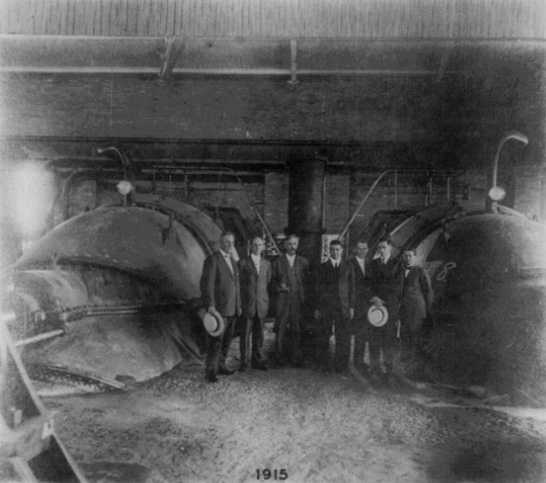 Al's
work was truly revolutionary. Some of Wood's pumps have been in almost
continuous use for over 80 years without need of repairs. New pumps
are still built from his designs. Al began some very ambitions
projects - and this is where the 'mad' mart of genius comes in... In
1927 a project was begun to fill in the shoreline of Lake Pontchartrain and
create levees along the lake side of the city. By the end of 1937,
Al's pumps had created 50,000 acres of dry land that was once permanent
swampland.
Al's
work was truly revolutionary. Some of Wood's pumps have been in almost
continuous use for over 80 years without need of repairs. New pumps
are still built from his designs. Al began some very ambitions
projects - and this is where the 'mad' mart of genius comes in... In
1927 a project was begun to fill in the shoreline of Lake Pontchartrain and
create levees along the lake side of the city. By the end of 1937,
Al's pumps had created 50,000 acres of dry land that was once permanent
swampland.
Al did far more than improve drainage. He created dry land where once there was open water. Protected by these new machines, people began building houses on reclaimed swampland. In time, not only would the city of New Orleans be 'created' this way, but entire parishes (counties) would be created nearly wholesale with this new technology.
Al's pumps and the levees proved adequate to protect the city from many dangers and improved the health and safety of the citizenry. Until 1927, the levees were strictly municipal projects paid for and maintained by the city. Other outlying towns had also begun creating their own levee systems. In the aftermath of the Great Mississippi Flood of 1927, however, the United States Congress federalized the levees and gave the United States Army Corps of Engineers supervision and control of design and construction of all the flood control systems throughout the Mississippi River Valley. The local levee boards were allowed to remain in charge of day to day inspection and maintenance of the levee systems in their areas but they were never provided Federal funds for that task.
Then on the Public Service Commission, future Governor Huey Long exclaimed, "Screw this! They're lying! The President's lying! The rich fat cats that are drowning you will do it again and again and again. They lead you into imperialist wars for profit, they take away your schools and your hope and when you complain, they blame Blacks and Jews and immigrants. Then they push your kids under. I say, Kick'm in the ass and take your rightful share!" Gotta love Uncle Huey. Unfortunately, nobody listened to that particular bit of wisdom - and 78 years later, his words would still be true - but I'm getting ahead of myself.
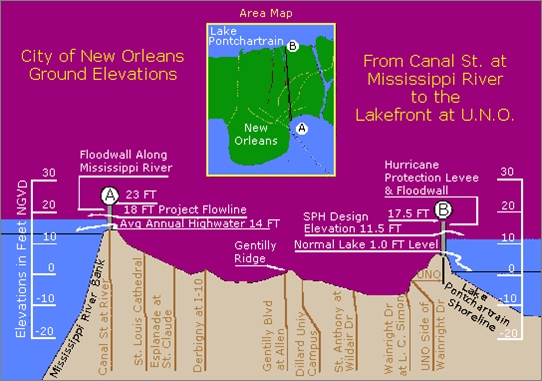
This image shows the elevation levels of a line running from the river (A) to the lake (B) from Canal Street at the river to the University of New Orleans.
The blue water levels show are maximum projected heights - well within the ability of the levees.
All was well until a hurricane came along. Levees for the Mississippi River Gulf Outlet along Florida Avenue in the Lower Ninth Ward and on both sides of the Industrial Canal failed. The flood water reached the eaves of houses in some places and over some one story roofs in the Lower Ninth Ward. Some residents drowned in their attics trying to escape the rising waters. Gentilly, the Upper Ninth Ward, and the Lower Ninth Ward of New Orleans as well as Arabi and Chalmette in neighboring St. Bernard Parish were all flooded. Over 164,000 homes were inundated. It was ten days or more before the water level in New Orleans went down enough for people to return to their homes. Those who did not have family or friends with dry homes had to sleep in the shelters at night and forage for supplies during the day, while waiting for the federal government to provide emergency relief in the form of trailers. No, this isn't Hurricane Katrina. It's Hurricane Betsy in 1965.
The U.S. Army Corps of Engineers' Hurricane Protection Program came into existence as a result of Betsy. The Corps built new levees for New Orleans that were both taller and made of stronger material, designed specifically to resist a Category 3 hurricane like Betsy.
Hurricane Camille, which took a similar track to Katrina, destroyed nearly all of the Mississippi gulf coast again in 1969 and caused damage in New Orleans. I was four months old at the time. My daddy managed to put a few boards up on the front window, and we all rode it out in our little house in Metairie. There were no evacuation orders, but the levees mostly held. Power was out for two and a half weeks.
We all know that several of these levees failed during Katrina. Why they failed is not difficult to comprehend, although spending many hours reading reports can confuse you. Let me spell it out plainly for those uneducated on the topic. The levees failed because they were improperly designed by the Corps of Engineers, improperly built by those hired to do so, and improperly inspected and maintained by the levee boards - who receive very little by way of state funds for that purpose.
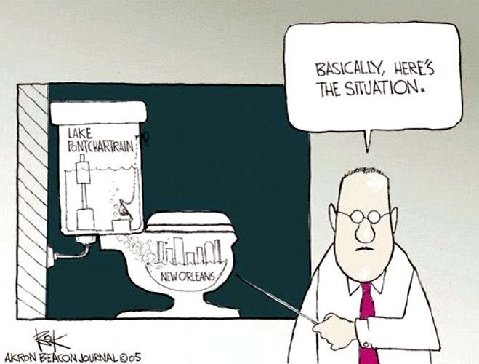 While
we will examine the failure of the levee system in some detail, it isn't
necessary to go into why at this point. (With my apologies to
Thoth...) We do, however, want to appreciate exactly where
they failed, when they failed, and in some cases how they
failed. Appreciating that will help us set a timeline of the disaster
and examine individual stories from which we can learn many lessons.
It's important to appreciate that in many areas, Katrina came and went with
some noise, rain, and wind - but not a whole lot of flooding. The water didn't rise in
many places until the next day.
While
we will examine the failure of the levee system in some detail, it isn't
necessary to go into why at this point. (With my apologies to
Thoth...) We do, however, want to appreciate exactly where
they failed, when they failed, and in some cases how they
failed. Appreciating that will help us set a timeline of the disaster
and examine individual stories from which we can learn many lessons.
It's important to appreciate that in many areas, Katrina came and went with
some noise, rain, and wind - but not a whole lot of flooding. The water didn't rise in
many places until the next day.
Through our history we have come to understand that New Orleans as a city has been destroyed to some degree and rebuilt several times. More than once in modern memory, in fact. Are these New Orleanians stupid, or are they stubborn? What about people on the Mississippi Gulf Coast? Again and again the cities and towns all along the coast are washed away, only to be rebuilt again. What's going on here? Are all these people smoking crack or something?
Some of them are, no doubt...
The answer is easy to articulate in some ways, and difficult in others. One answer has to do with Home. Another answer has to do with the strategic and economic importance of the region. We have examined the history of New Orleans itself, but the history of New Orleans is also the history of the Gulf Coast from Pensacola, Florida to Galveston, Texas. New Orleans is an island in some ways, but it has an influence over the entire region in many other ways. Vast amounts of the nations oil come from and through Louisiana. New Orleans is the economic engine of Louisiana and in a lesser way of the Gulf South. I'll admit that our Mississippi brothers have been kicking our economic keisters for the last few years. We'll see how that plays out in the end...
To ask the question, "Why rebuild a city built below sea level?", is a question of cowards and other choice words I cannot use in public. It is no different to ask, "Why rebuild anything where the Twin Towers stood?" If we lose New Orleans, we lose more than the city. We lose a part of America. I have been quite shocked to hear some Americans say that they would prefer to see an American city die than thrive - but I'm getting ahead of myself again.
I suppose I'm winding up to get righteous on a few people. More than a few, really. Greg Palast remarked, "There is no such thing as a 'natural' disaster. Hurricanes happen, but death comes from official neglect, from tax cuts for the rich that cut the heart out of public protection. The corpses in the street are victims of a class war in which only one side has a general. Where is our Huey Long?" Well, we're going to summon Uncle Huey's ghost. I'm sure the first thing Huey will want to do is kick Greg Palast square in the testicles.
It is now 7:00 AM on Monday, August 29. I do not know it yet, but the levees are already failing. The first failure was as early as 4:30 AM on the north side of the Industrial Canal in New Orleans East. Due to a train derailment, the metal floodgates were not working at the CSX Railroad crossing. Sandbags had been placed to seal the levee walls. Eventually the storm surge reaches nine feet above sea level, and the sandbags give way. We see, then, that the why of the first levee failure is nothing more than bad luck. It's just the first murmur of the heart attack to come.
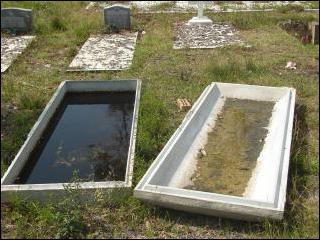 In our work to examine the failures of men, and the failures of nature, we
will need several August Personages. We will need Uncle Huey for sure.
We'll need Al Wood, Sam Clemens, Bienville, old Marty Behrman, and more
besides.
In our work to examine the failures of men, and the failures of nature, we
will need several August Personages. We will need Uncle Huey for sure.
We'll need Al Wood, Sam Clemens, Bienville, old Marty Behrman, and more
besides.
Arise now you specters! Come out of your tombs and walk along with us in the daylight! Come along, you old ghosts! Come and see what they have done to us! Come and see what Katrina has done to us! Come and see what we have done to ourselves!
I would call others - our fathers and our grandfathers - but they cannot come. They cannot hear us. The salty waters of the Gulf of Mexico are washing through their graves.
Shane
